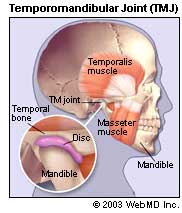
How often have you heard someone say “I have TMJ”?
In truth, we each have two TMJ’s. TMJ is common abbreviation for the Temporomandibular Joint. We have a left TMJ and a right TMJ. There is an articular disc between the temporal bone and the mandible. The TMJ is a synovial joint. The subtype is a modified hinge allowing us to open and close our mouth; speaking, chewing, yawning.
TMJ dysfunction is a general term that applies to any abnormal function of the TMJ. There are many possible causes of TMJ dysfunction. One cause could be tight or imbalanced muscles that cross the joint. The muscles of the TMJ are masseter, temporalis, medial pterygoid and lateral pterygoid.
Symptoms of TMJ dysfunction include pain in the head, neck, shoulder, ear, or mouth, clicking or locking of the jaw and loss of range of motion of the jaw.
Both massage and especially cranio-sacral treatments can be beneficial and effective if intervention is begun before bony deformation begins.
JAN

About the Author: